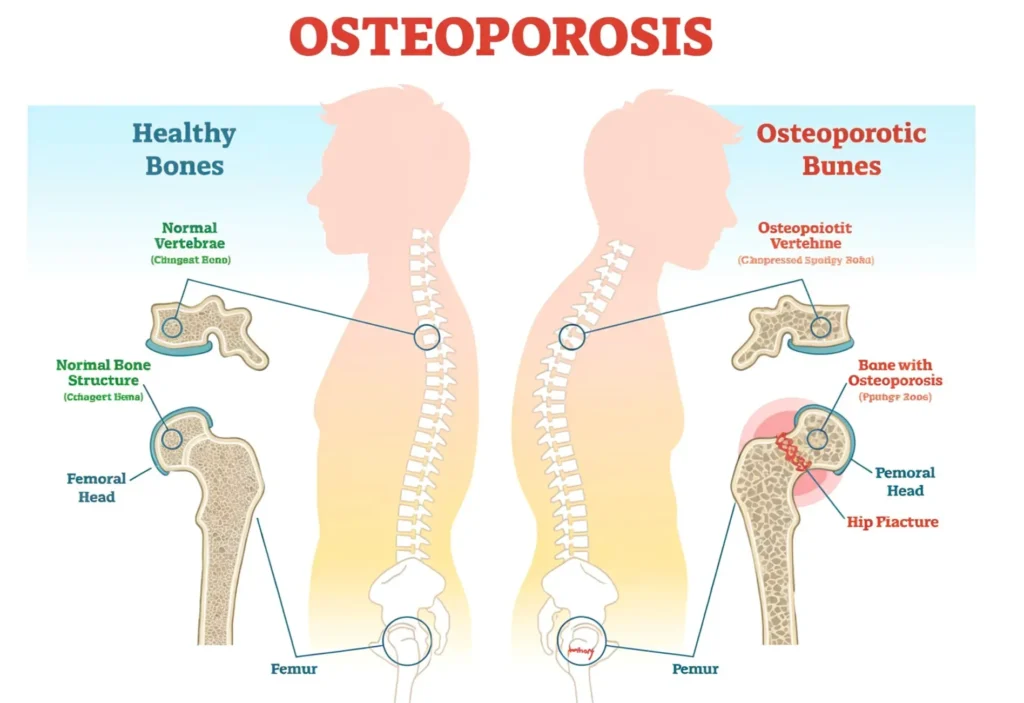Osteoporosis in men is a condition that weakens bones, causing them to become fragile and brittle. While often associated with women, osteoporosis also affects men, especially as they age. The condition develops slowly and often goes unnoticed until a fracture occurs. Understanding osteoporosis and men is vital for early detection and prevention. This blog explores causes, symptoms, and treatments, offering practical tips for maintaining strong bones and reducing risks associated with brittle bones in men.

What is Osteoporosis?
Osteoporosis occurs when bones lose density, making them weak and more likely to break. It affects both men and women, though it’s less commonly diagnosed in men. Osteoporosis treatment men includes medication, dietary changes, and weight-bearing exercises. Untreated, it can lead to severe fractures in hips, wrists, and spine. Proper care and early detection can greatly reduce risks. Knowing about osteoporosis and men helps address the unique challenges men face when dealing with this condition.
Understanding Osteoporosis in Men
Osteoporosis often develops later in life. Unlike women, who experience bone loss rapidly after menopause, men tend to lose bone density gradually. Osteoporosis in men often goes undetected until a fracture occurs. Factors such as low testosterone, lack of exercise, and poor diet contribute to bone loss. By understanding the unique ways osteoporosis impacts men, it’s possible to focus on early prevention and tailored treatment approaches for osteoporosis treatment in men.
Causes
Osteoporosis in men causes include:
- Low testosterone levels
- Poor calcium and vitamin D intake
- Smoking and excessive alcohol consumption
- Sedentary lifestyle
- Family history of osteoporosis
Osteoporosis can also result from medical conditions like diabetes or long-term use of certain medications. Effective osteoporosis treatment men targets these underlying causes. Addressing risk factors early can prevent brittle bones and reduce fracture risks.
Symptoms
Osteoporosis in men often shows no symptoms until a fracture occurs. Key signs include:
- Frequent fractures, even with minor falls
- Back pain caused by spinal fractures
- Height loss over time
Brittle bones make daily activities risky if left untreated. Watch for these symptoms to detect bone weakness early. Timely action and osteoporosis treatment in men can prevent fractures and maintain quality of life.
Risk Factors
Risk factors for osteoporosis in men include:
- Advanced age
- Smoking and excessive alcohol use
- Poor diet lacking in calcium and vitamin D
- Chronic diseases like arthritis or thyroid disorders
Understanding these risks is critical for preventing brittle bones in men. Regular checkups and a proactive approach to bone health can significantly lower your risk of developing osteoporosis in men.
Diagnosis and Tests
Doctors diagnose osteoporosis in men through bone density tests like DXA scans. Blood tests may also identify underlying causes, such as low testosterone. If fractures occur, imaging tests help determine the extent of bone damage. Knowing the osteoporosis in men causes and seeking regular screenings are vital. Early detection can ensure effective osteoporosis treatment men, preventing further bone loss and complications.
Prevention
Preventing brittle bones in men starts with healthy habits:
- Eat a calcium-rich diet (milk, cheese, leafy greens).
- Spend time outdoors for vitamin D.
- Engage in weight-bearing exercises like walking or lifting weights.
By maintaining a balanced lifestyle, you can reduce the risks of osteoporosis in men. Prevention is easier than treatment, and small changes now can lead to a lifetime of strong bones.

Medical Treatment Options
Effective treatment includes:
- Medications like bisphosphonates or testosterone therapy
- Supplements for calcium and vitamin D
- Physical therapy to strengthen muscles
Treatment plans depend on individual needs and severity. Addressing osteoporosis early ensures the best outcomes. Regular follow-ups and a tailored approach can help maintain bone density and prevent fractures.
Conclusion
Osteoporosis in men is a condition that requires attention and care. By understanding the causes of osteoporosis and recognizing symptoms early, it’s possible to reduce risks and live an active, healthy life. Whether through prevention or osteoporosis treatment men, proactive measures make a significant difference. Protect your bone health and spread awareness about this often-overlooked issue.

